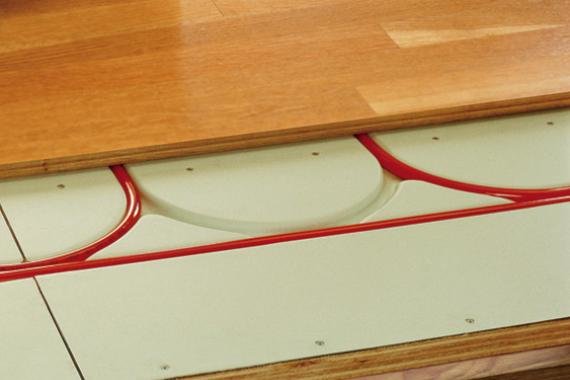We may earn revenue from the products available on this page and participate in affiliate programs. Learn More ›
As summer heat gives way to fall’s cooler temperatures, daily activities—from dinners to DIY projects—migrate back indoors. But really, how much more comfortable are you indoors with your current home heating system? Sure, being inside provides shelter from the elements, but it doesn’t always guarantee a consistent temperature (even when you’ve properly sealed off all air leaks to the outdoors).
When you still have to bundle up before walking across your home’s icy floors or need to curl up with a blanket to work comfortably, you may wonder, What am I paying so much each month to heat?
The answer is, you’re probably paying most to heat the ceiling and second floor rather than your primary living space. Settling for uneven temperatures or a heating system that underperforms isn’t the only option. Instead, consider a more direct, dependable, and energy-efficient alternative: radiant heat.

Radiant-heating systems aren’t new. In fact, ancient Korea used controlled fires to heat air chambers under floors and behind walls. Fast-forward a few thousand years, and the highly evolved innovative materials and designs behind today’s modern systems are capable of providing efficient, uniform heat that offers numerous advantages over traditional HVAC systems.
Their silent, dust-free operation eliminates allergy problems often associated with heating ducts while distributing even heat underfoot. And, on top of all these benefits, radiant heating built into your home’s flooring aims to keep the living space comfortable—no matter how tall the ceiling.
Why Forced Air Falls Short
If you currently rely on forced-air heat and are fed up with its less-than-stellar performance, don’t be too quick to put all the blame on your heating system. The way your home is designed plays a part in how efficiently (or inefficiently) the rooms warm up. Think back to your elementary school science lessons, and remember: Hot air rises. When your forced-air heating system pushes heat out of its vents, the heat naturally rises toward the ceiling. Your rooms become cozily warm at the top, but remain chilly down below, where you do your actual living.
To cope, shivering homeowners may move closer to the nearest vent or resort to cranking up the thermostat to achieve a comfortable temperature at ground level, producing more heat than actually necessary and ultimately costing more money to do so. For rooms with standard 9-foot ceilings, this law of science is simply an inconvenience; but in the case of high ceilings, upwards of 12 feet, it can be costly. In a two-story house, the result is too much heat upstairs, and the only solution is to open some windows to let the heat (the heat that you’ve just paid for) escape the house. What’s a homeowner to do?
Concentrating Heat Where You Need It Most
While forced-air systems push heat into a room in cycles, unaffected surrounding surfaces can remain cool to the touch and actually steal warmth from your body, leaving you chilly despite the fact that your heating system is working overtime. Radiant floor heating systems, on the other hand, are designed to deliver even heat throughout your rooms by radiating constant warmth from beneath your flooring. The process warms the cooler areas it encounters first—the floor, the furniture, and the people occupying the living space. Because radiant heat warms objects in the room as well as people, you won’t be giving up body heat to, say, that favorite chair of yours. It, too, will emit a welcoming warmth when you sit down, rather than cause you to reach for the nearest woolen blanket.

Choosing the Most Efficient Radiant System
Before committing to an upgraded heating setup, be it in that one lofty room or your whole house, working knowledge of the systems can help you optimize your energy savings with this already highly efficient system. Radiant floor heating travels through flexible hydronic tubes or electric coils installed either inside or adjacent to panels laid beneath your flooring material of choice. The system’s energy source and materials do vary from manufacturer to manufacturer and considerably impact the energy efficiency of this heating system.
Hydronic radiant floor systems lower fuel bills by utilizing a boiler to heat water within a network of tubes beneath your home flooring to relatively low temperatures. Because the whole floor receives even heat, the water doesn’t have to be as hot as what might run through a conventional radiator.
For best possible heat transfer, panels should be made with a very conductive material—aluminum is the most common. Depending on the specific alloy, aluminum can conduct heat 232 times more efficiently than lightweight gypsum concrete, a standard alternative. Put simply, a material that offers better heat transfer means you’ll get more heat, more quickly, and for less energy (and less money). The thin, highly conductive panels produced by industry leader Warmboard require the least energy to operate of any radiant-heating system, providing the same comfort as competing systems while the water in the hydronic tubes can be more than 30 degrees lower than the others. That alone translates into a 10 to 20 percent savings in your monthly energy bills compared to other radiant options!
Whether you are building a brand-new home with a bold design or already live with the luxury of high ceilings, you can ensure affordable everyday comfort by opting for radiant floor heating. Even if the ceiling heights in your home extend only slightly above average, there are enough compelling reasons to choose radiant heat—its ease on allergies, quiet operation, and seasonal energy savings—that the system shines in lofty areas and smaller home additions alike. Install a state-of-the-art radiant-heating system, and you and your family will enjoy its benefits for years to come.
This post has been brought to you by Warmboard. Its facts and opinions are those of BobVila.com.
